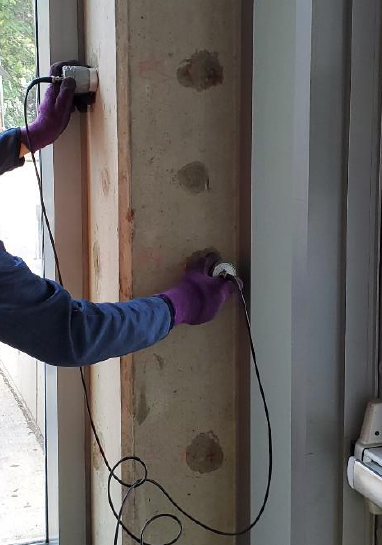Scope
 FPrimeC Solutions was retained by Stephenson Engineering Ltd. (Client) to perform non-destructive evaluation of concrete column in a university building in Toronto, ON. The client was interested to evaluate the present condition of existing cracks on the exterior face of the concrete column, and inspect to what extend the cracks propagated into the column. The main objective of the project was to study the existing cracks in the reinforced concrete column using non-destructive testing technology.
FPrimeC Solutions was retained by Stephenson Engineering Ltd. (Client) to perform non-destructive evaluation of concrete column in a university building in Toronto, ON. The client was interested to evaluate the present condition of existing cracks on the exterior face of the concrete column, and inspect to what extend the cracks propagated into the column. The main objective of the project was to study the existing cracks in the reinforced concrete column using non-destructive testing technology.

Solution: Non-Destructive Testing and Evaluation
Following communication with the client, a multi-technology approach involving different non-destructive testing methods was proposed to the client. The proposed solution involved four major steps:
- Visual Inspection
- Ground Penetrating Radar – GPR (Learn more)
- Ultrasonic Pulse Echo (UPE) (Learn more)
- Ultrasonic Pulse Velocity (UPV) (Learn more)
GPR Scanning was used to determine the location of embedded rebar / wire mesh in concrete prior to ultrasonic testing. Ultrasonic Pulse Echo (UPE) was used to determine the potential subsurface defects and anomalies. UPE uses shear waves to detect major voids and discontinuities in concrete. The main objective was to examine the concrete column for any potential discontinuity within the original structural column. Ultrasonic Pulse Velocity (UPV) was used to verify the quality of concrete and examine sub-surface voids or discontinuities that might negatively impact structural integrity of the column. The ultrasonic testing was conducted according to the recommendations of the ASTM C-597 and the measurements were used to examine if any major discontinuity exist within the column. The condition of the column was evaluated using advanced Seismic Tomography concept (Learn More).
